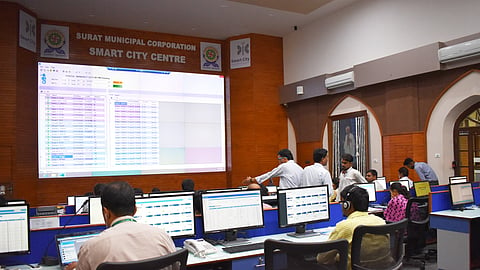Surat upgrades to ABB’s digital water management solution
ABB India is enabling the digitalisation of the entire water management system of Surat with its GSM (Global System for Mobile communications) enabled AquaMaster flowmeters solution to measure water consumption in real-time. The next level technology will help the Surat Municipal Corporation (SMC), the governing civic authority, study consumption patterns and explore areas of improvement for better water management, moving Surat ahead in its journey to becoming a Smart City.
ABB first installed manual flowmeters for water measurement in the city in 2005. With the advent of digital technology and Surat making it to the list of 100 Smart Cities, ABB partnered with the city municipal corporation to deploy a more scalable and sustainable model, by upgrading the existing manual flowmeters to digitally-enabled devices. SMC has already installed over 240 flowmeters across the Pandesaran area of the city which has numerous textile mills, and other locations in the city such as engineering college, hospitals and hotels.
“Digitally monitoring the consumption of a critical resource like water will help in more equitable distribution and optimize water management for the benefit of the population of Surat city. We are proud to partner and congratulate Surat’s administrators for their vision and actions to adopt our world-class digital flowmeter solution, which will help the city scale up and transition sustainably into a Smart city,” said, Sanjeev Sharma, Managing Director, ABB India.
“ABB flowmeters are operating in five cities of Delhi, Bangalore, Ranchi, Kolkata and Chennai to ensure efficient monitoring, tracking and billing water usage. We believe that this is a key step for the city corporations to reduce the share of non-revenue water as India steps into the era of smart cities and optimized usage of natural resources,” Sharma added.
ABB’s flowmeters installed in the inlet pipes of the municipal water lines enables automatic meter reading (AMR) that measures water flow and send precise readings to the corporation’s central control center through GSM connection in real-time, eliminating the burden of manual data collection and reducing error in readings. The data collected from the readings will provide computer-generated monthly and quarterly reports on the consumption patterns.
At present, the textile mills in the city consume over 50 per cent of the water supplied by SMC, while the remaining amount is consumed by households and other commercial establishments in the city. However, going forward, the corporation will be able to use the detailed information on the timings of the usage and the peak hours of usage to optimize water management. As per a World Bank report, if the water losses in developing countries could be halved or the share of non-revenue water cut down, the saved water would be enough to supply around 90 million people.

